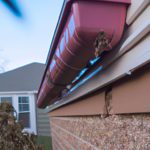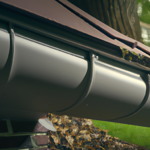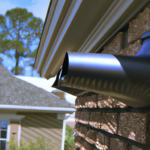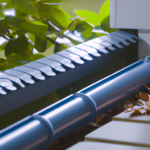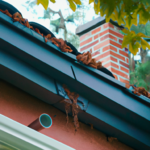-
Table of Contents
- Introduction
- The Early Days of Gutters: A Look at How Ancient Civilizations Managed Rainwater
- From Wood to Metal: The Evolution of Gutter Materials
- The Industrial Revolution and the Rise of Mass-Produced Gutters
- The Modern Gutter: Innovations in Design and Functionality
- The Future of Gutters: How Technology is Changing the Way We Manage Rainwater
- Q&A
- Conclusion
Discover the story of gutters: from ancient times to modern homes.
Introduction
Gutters have been an important part of homes for centuries, serving the purpose of directing rainwater away from the roof and foundation. Over time, gutters have evolved from simple wooden troughs to more advanced systems made of materials such as aluminum, copper, and vinyl. In this article, we will explore the history and evolution of gutters, from their earliest origins to the modern systems we use today.
The Early Days of Gutters: A Look at How Ancient Civilizations Managed Rainwater
Gutters are an essential part of our homes, but have you ever wondered about their history and evolution? Gutters have been around for centuries, and their design and purpose have changed over time. In this article, we will take a look at the early days of gutters and how ancient civilizations managed rainwater.
The earliest known gutters were used by the ancient Egyptians, who built their homes with flat roofs. These roofs were designed to collect rainwater, which was then channeled into gutters made of stone or clay. The gutters were then connected to underground drainage systems, which carried the water away from the home.
The ancient Greeks and Romans also used gutters to manage rainwater. The Greeks built their homes with sloping roofs, which allowed rainwater to flow into gutters made of marble or terracotta. The gutters were then connected to underground drainage systems, which carried the water away from the home. The Romans, on the other hand, used lead gutters, which were more durable and long-lasting than the gutters used by the Greeks.
During the Middle Ages, gutters were not commonly used in Europe. Instead, homes were built with steeply pitched roofs, which allowed rainwater to run off quickly. However, as cities grew and homes were built closer together, gutters became more necessary. In the 18th century, wooden gutters were introduced in Europe, but they were not very durable and required frequent maintenance.
It wasn’t until the 19th century that metal gutters became popular in Europe and the United States. Copper and galvanized steel were the most commonly used materials, and they were much more durable than the wooden gutters of the past. These gutters were also easier to install and required less maintenance.
In the 20th century, gutters became even more essential as homes became larger and more complex. New materials, such as aluminum and vinyl, were introduced, which were even more durable and required even less maintenance. These materials also allowed for more customization, as gutters could be made in a variety of colors and styles to match the home’s exterior.
Today, gutters are an essential part of any home. They protect the home’s foundation from water damage, prevent erosion, and keep water from entering the home. Gutters are available in a variety of materials, including aluminum, vinyl, and copper, and can be customized to match the home’s exterior.
In conclusion, gutters have come a long way since their early days in ancient civilizations. From stone and clay gutters to modern aluminum and vinyl gutters, the design and purpose of gutters have evolved over time. Today, gutters are an essential part of any home, protecting the home’s foundation and preventing water damage. So the next time it rains, take a moment to appreciate the humble gutter and all that it does to keep your home safe and dry.
From Wood to Metal: The Evolution of Gutter Materials
Gutters are an essential part of our homes, but have you ever wondered about their history and evolution? Gutters have been around for centuries, and they have come a long way from their humble beginnings. In this article, we will take a look at the history and evolution of gutters, from their earliest days to the modern materials used today.
The earliest gutters were made of wood, and they were used to channel rainwater away from buildings. These gutters were simple in design, and they were often made by hand. The wood was shaped into a trough, and it was attached to the roofline of the building. The water would flow down the roof and into the gutter, where it would be directed away from the building.
As time went on, gutters became more sophisticated. In the 18th century, cast iron gutters were introduced. These gutters were stronger and more durable than their wooden counterparts, and they could be made in longer lengths. Cast iron gutters were also more decorative, and they were often used on high-end homes and buildings.
In the 19th century, galvanized steel gutters were introduced. These gutters were made by coating steel with a layer of zinc, which made them resistant to rust and corrosion. Galvanized steel gutters were also more affordable than cast iron gutters, which made them more accessible to the average homeowner.
In the 20th century, aluminum gutters became popular. Aluminum gutters were lightweight, easy to install, and they did not rust or corrode. Aluminum gutters were also available in a variety of colors, which made them a popular choice for homeowners who wanted to match their gutters to their home’s exterior.
Today, there are many different materials used to make gutters. PVC and vinyl gutters are popular because they are lightweight, easy to install, and they do not rust or corrode. Copper gutters are also popular because they are durable and they develop a beautiful patina over time.
In addition to the materials used to make gutters, there have also been many advancements in gutter technology. Gutter guards, for example, are a relatively new invention. Gutter guards are designed to keep debris out of gutters, which can help prevent clogs and other issues. There are many different types of gutter guards available, including mesh screens, foam inserts, and solid covers.
Another advancement in gutter technology is the use of seamless gutters. Seamless gutters are made from a single piece of material, which eliminates the need for seams. This makes them less prone to leaks and other issues, and it also makes them more aesthetically pleasing.
In conclusion, gutters have come a long way since their earliest days. From wooden troughs to modern materials like PVC and copper, gutters have evolved to become an essential part of our homes. With advancements in technology like gutter guards and seamless gutters, gutters are now more effective and efficient than ever before. Whether you are building a new home or replacing your old gutters, it is important to choose the right materials and technology to ensure that your gutters will last for many years to come.
The Industrial Revolution and the Rise of Mass-Produced Gutters

Gutters have been around for centuries, but it wasn’t until the Industrial Revolution that they became a common feature on homes. Prior to this, gutters were typically made of wood or stone and were only found on the most affluent homes.
During the Industrial Revolution, the mass production of metal goods became possible, and this included gutters. Cast iron gutters were the first to be produced on a large scale, and they quickly became popular due to their durability and strength.
However, cast iron gutters were heavy and difficult to install, which made them expensive. This led to the development of lighter and more affordable materials, such as aluminum and vinyl.
Aluminum gutters were first introduced in the 1960s and quickly became popular due to their lightweight and rust-resistant properties. They were also easy to install, which made them a favorite among DIY enthusiasts.
Vinyl gutters were introduced in the 1970s and were even lighter than aluminum gutters. They were also less expensive and required less maintenance than other materials.
Today, gutters are an essential part of any home’s exterior. They are designed to collect rainwater and direct it away from the foundation of the house, which helps to prevent water damage and erosion.
Gutters come in a variety of shapes and sizes, including half-round, K-style, and box gutters. They can also be made from a variety of materials, including aluminum, vinyl, copper, and steel.
One of the most significant advancements in gutter technology has been the development of seamless gutters. These gutters are made from a single piece of material, which eliminates the need for seams that can leak or become clogged with debris.
Another recent development in gutter technology is the addition of gutter guards. These are devices that are installed over the top of the gutter to prevent leaves, twigs, and other debris from clogging the gutter. Gutter guards can be made from a variety of materials, including mesh, foam, and brush.
In addition to their practical function, gutters can also add to the aesthetic appeal of a home. They come in a variety of colors and styles, which allows homeowners to choose a gutter system that complements the overall design of their home.
In conclusion, gutters have come a long way since their humble beginnings as wooden troughs. The Industrial Revolution and the rise of mass-produced gutters paved the way for the development of lighter and more affordable materials, such as aluminum and vinyl. Today, gutters are an essential part of any home’s exterior, and advancements in technology have made them more effective and easier to maintain than ever before. Whether you’re looking for a practical solution to protect your home from water damage or a way to enhance its curb appeal, there’s a gutter system out there that’s perfect for your needs.
The Modern Gutter: Innovations in Design and Functionality
Gutters have come a long way since their humble beginnings. Originally, gutters were made of wood and were used to channel rainwater away from the roof and foundation of a home. However, as time went on, gutters evolved to become the essential part of our homes they are today.
One of the biggest innovations in gutter design was the introduction of aluminum gutters in the 1960s. Aluminum gutters were lightweight, durable, and easy to install, making them a popular choice for homeowners. They also came in a variety of colors, allowing homeowners to choose a gutter that matched the color of their home.
Another innovation in gutter design was the introduction of seamless gutters. Seamless gutters are made from a single piece of metal, which eliminates the need for seams that can leak and cause damage to the home. Seamless gutters are also custom-made to fit the exact dimensions of the home, ensuring a perfect fit and maximum protection against water damage.
In recent years, gutter guards have become a popular addition to gutters. Gutter guards are designed to keep debris such as leaves, twigs, and other debris from clogging the gutters. This not only reduces the need for gutter cleaning but also helps to prevent water damage to the home.
Another innovation in gutter design is the use of rain chains. Rain chains are decorative chains that are hung from the gutter downspout. They are designed to channel rainwater away from the home in a decorative and visually appealing way. Rain chains come in a variety of styles and materials, including copper, brass, and aluminum.
In addition to these innovations in gutter design, there have also been advancements in gutter installation techniques. For example, some companies now use a machine to create seamless gutters on-site, which eliminates the need for seams and reduces the risk of leaks. Other companies use drones to inspect gutters and identify any potential issues before they become a problem.
Overall, the evolution of gutters has been driven by a desire to improve their functionality and make them more aesthetically pleasing. Today, gutters are an essential part of any home, providing protection against water damage and helping to maintain the structural integrity of the home. With continued innovation and advancements in technology, it is likely that gutters will continue to evolve and improve in the years to come.
The Future of Gutters: How Technology is Changing the Way We Manage Rainwater
Gutters have been around for centuries, dating back to ancient civilizations such as the Greeks and Romans who used them to collect rainwater for irrigation and drinking. However, it wasn’t until the 18th century that gutters became a common feature in homes, primarily in Europe and North America.
Initially, gutters were made of wood or stone and were attached to the roofline with metal brackets. These early gutters were not very effective at collecting rainwater, and often became clogged with debris, causing water to overflow and damage the home’s foundation.
In the 19th century, cast iron gutters were introduced, which were more durable and effective at collecting rainwater. However, they were also heavy and difficult to install, making them less popular among homeowners.
It wasn’t until the 20th century that aluminum and vinyl gutters were introduced, which revolutionized the gutter industry. These materials were lightweight, easy to install, and required little maintenance, making them the preferred choice for homeowners.
Today, gutters are an essential part of any home’s exterior, protecting the foundation and landscaping from water damage. However, with the advancement of technology, gutters are evolving once again.
One of the most significant changes in gutter technology is the introduction of seamless gutters. Unlike traditional gutters, which are made of several sections joined together, seamless gutters are made from a single piece of material, reducing the risk of leaks and clogs.
Another technological advancement in gutters is the use of gutter guards. These are screens or covers that are placed over the gutters to prevent debris from entering and clogging the system. Gutter guards not only reduce the need for regular maintenance but also improve the overall efficiency of the gutter system.
In addition to seamless gutters and gutter guards, there are also smart gutters that are equipped with sensors and other technology to monitor and manage rainwater. These gutters can detect when it’s raining and adjust the flow of water accordingly, ensuring that the water is directed away from the home’s foundation and landscaping.
Smart gutters can also be connected to a home automation system, allowing homeowners to control the flow of water from their smartphones or other devices. This technology not only makes it easier to manage rainwater but also helps to conserve water by directing it to areas where it’s needed most.
As technology continues to advance, it’s likely that gutters will continue to evolve and become even more efficient and effective at managing rainwater. Whether it’s through the use of sensors, automation, or other innovations, the future of gutters is bright.
In conclusion, gutters have come a long way since their humble beginnings in ancient civilizations. From wood and stone to aluminum and vinyl, gutters have evolved to become an essential part of any home’s exterior. With the introduction of seamless gutters, gutter guards, and smart gutters, the future of gutters is looking brighter than ever. As technology continues to advance, it’s exciting to think about what the future holds for this essential part of our homes.
Q&A
1. What is the history of gutters?
Gutters have been used for thousands of years, with evidence of their use dating back to ancient civilizations such as the Greeks and Romans.
2. How have gutters evolved over time?
Gutters have evolved from simple channels carved into stone or wood to more complex systems made of materials such as copper, aluminum, and vinyl. They have also become more efficient at directing water away from homes.
3. When did gutters become an essential part of homes?
Gutters became an essential part of homes in the 20th century, as they were recognized as a necessary component for protecting homes from water damage.
4. What are some common materials used for gutters today?
Common materials used for gutters today include aluminum, copper, steel, and vinyl.
5. What are some benefits of having gutters on a home?
Benefits of having gutters on a home include protecting the foundation from water damage, preventing erosion, and keeping water away from the home’s exterior walls and windows.
Conclusion
Gutters have a long and interesting history, dating back to ancient civilizations. Over time, gutters have evolved to become an essential part of our homes, protecting them from water damage and improving their overall functionality. Today, gutters come in a variety of materials and styles, and are an important aspect of any home’s design and maintenance.
